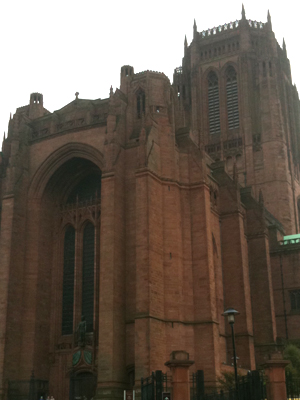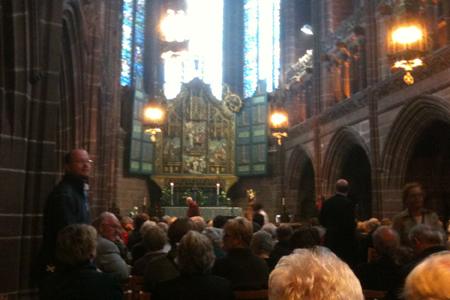| |
 |
 |
 |
| Comment on this report, or find other reports. |
 |
| Our Mystery Worshippers are volunteers who warm church pews for us around the world. If you'd like to become a Mystery Worshipper, start here. |
 |
| Find out how to reproduce this report in your church magazine or website. |
|
|
| 1831: Cathedral
Church of Christ, Liverpool, England |
 |
 |
 |
Mystery Worshipper:
Strange Pilgrim.
The church:
Cathedral
Church of Christ, Liverpool, England.
Denomination:
Church of England, Diocese
of Liverpool.
The building:
The diocese was founded in 1880, but the decision to build the
cathedral was not made until 1901. It is the largest cathedral
in Britain (and one of the largest in the world), designed by
the then 22-year-old architect Giles Gilbert Scott. He was supervised
in the early stages by the elderly and distinguished GF Bodley,
whose influence is strong on the design of the Lady chapel,
where this service took place. It is undoubtedly impressive,
but many people feel it can be rather overwhelming and lacks
warmth. Although it is in the gothic style, it is unlike any
mediaeval cathedral.
The church:
The usual cathedral congregation consists of a core of regulars,
many commuting from the suburbs, along with a large number of
visitors. Large diocesan and civic services, or regional events
like this one, attract a quite different crowd. The cathedral
staff are well-used to coping with such a variety of clientele.
This particular service was a small part of a whole dayís events
that included activities for children and young people as well
as a more traditional pilgrimage programme, including two solemn
masses, and the cathedral was full of people of all ages from
all parts of the north-west of England (and probably Wales).
The congregation at evensong were predominantly middle-aged
and older, and almost entirely white.
The neighbourhood:
The cathedral dominates its surrounding area, being situated
on high ground to the east of the city centre, and just a short
walk from its erstwhile Roman Catholic rival, now ecumenical
partner, Cathedral of Christ the King. To the east are the elegant
terraces of Georgian Liverpool, now well on the way to gentrification
after years of neglect; to the south is the multi-ethnic inner-city
area of Toxteth; to the west, recent housing for cathedral clergy
and others, and one of the oldest Chinese communities in Europe
(now graced with a massive decorated archway).
The cast:
The Rt Revd Martyn Jarrett, Bishop of Beverley, presided, accompanied
by the Very Revd Justin Welbyn, Dean of Liverpool, and the Revd
Canon Myles Davies, canon precentor. A number of other robed
clergy and servers assisted. The cathedral choir sang the music
of the office and two anthems.
The date & time:
Saturday, 10 October 2009, 3.00pm.
What was the name of the service?
Solemn Evensong and Benediction for the Liverpool Walsingham
Festival.
How full was the building?
The Lady chapel is the size of a moderately large parish church;
I would imagine it seats at least 300 people. There were no
spare seats and many people were standing in the aisles.
Did anyone welcome you personally?
This service was part of a whole dayís programme, and I am sure
that people arriving for this would have been made welcome.
I was approached by a volunteer in a specially designed t-shirt
and invited to light a candle before the blessed sacrament,
which was exposed on the high altar, before I moved into the
Lady chapel.
Was your pew comfortable?
Typical cathedral chairs with rush seats, which were very comfortable
for sitting in but (understandably in the circumstances) had
been pushed too closely together to allow for comfortable kneeling.
How would you describe the pre-service
atmosphere?
There was an atmosphere of joy and expectancy, but also much
chatting. Although the organ began to play loudly about a quarter
of an hour beforehand, some people continued to chat until the
service began.
What were the exact opening
words of the service?
The service began with a Latin anthem that seemed to be a version
of the Angelus. Hence the opening words were probably "Angelus
Domini nuntiavit Mariæ" although I couldnít
quite hear. The office proper began: "O Lord, open thou
our lips."
What books did the congregation
use during the service?
A specially produced booklet with a lovely colour photograph
of Our Lady of Walsingham.
What musical instruments were played?
Organ, which is I believe a separate instrument from that in
the main cathedral, but powerful nevertheless.

Did anything distract you?
The statue of Our Lady of Walsingham was set up on the other
side of the altar from the cathedralís own statue of Our Lady,
who is in a kneeling position. Hence it looked strangely like
she was praying to herself. Also, the bell that was rung to
accompany the blessed sacrament sounded just like an old-fashioned
telephone, and I kept wondering who was going to answer it.
Was the worship stiff-upper-lip, happy clappy, or
what?
A fascinating mix of sombre cathedral dignity and slightly po-faced
but prayerful and reverent Anglo-catholicism. It was good to
see (and smell!) some of rich devotional aids of the Catholic
tradition in a cathedral that has often been seen as the flagship
of a consciously Protestant diocese.
Exactly how long was the sermon?
There was no sermon.
Which part of the service
was like being in heaven?
Joining in the enthusiastic singing of the three hymns, and
recalling that the entire life of the city and the world gained
its meaning from the Presence that we worshipped on the altar
and that Mary brought to birth.
And which part was like being in... er... the other place?
Nothing as bad as that, but I felt a slight nagging guilt at
hogging a seat when so many were standing. And although the
Lordís Prayer was printed in bold for all to join in, it was
sung instead to a complicated setting by the choir.
What happened when you hung around after the service looking lost?
I bumped into one or two people whom I knew. It wasnít a typical
after-service socialising because mass was about to start. As
with the welcome, there were plenty of volunteers on hand to
ensure that nobody would feel lost.
How would you describe the after-service
coffee?
Tea and coffee were being dispensed in paper cups, but I didnít
stay as Iíd missed my lunch and needed slightly more encouraging
sustenance.
How would you feel about making this church your regular (where 10 = ecstatic, 0 = terminal)?
7 – If this church were to exist apart from at rare jamborees
like this, I would be happy to join it. The devotion and liturgical
dignity would encourage me, but I am suspicious of the underlying
clericalism still apparent in the anglo-catholic movement.
Did the service make you feel glad to be a
Christian?
Very much so. It was a welcome reminder that despite the many
obituaries written on the Christian church, the Church of England
and the Anglo-catholic movement, there is much life and hope
around still. It was also encouraging that divisions over the
ordination of women, or more long-standing tensions between
Catholic and Evangelical, were peripheral compared to the joy
of celebrating the incarnation.
What one thing will you remember about all this in seven days' time?
Liverpool Cathedral (which is probably about as big as the entire village of Walsingham) transformed into the Shrine of our Lady for the day. And the fragrant but unusual (for this venue) smell that greeted the nostrils on entering. |
|
|
 |
 |
 |
| We rely on voluntary donations to stay online. If you're a regular visitor to Ship of Fools, please consider supporting us. |
 |
 |
 |
| The Mystery Pilgrim |
 |
| One of our most seasoned reporters makes the Camino pilgrimage to Santiago de Compostela in Spain. Read here. |
 |
 |
 |
| London churches |
 |
| Read reports from 70 London churches, visited by a small army of Mystery Worshippers on one single Sunday. Read here. |
| |
|
|
|
|


